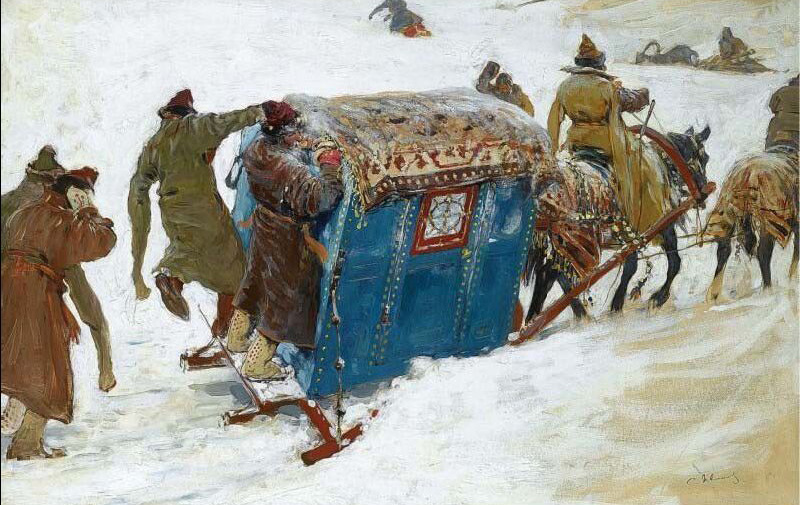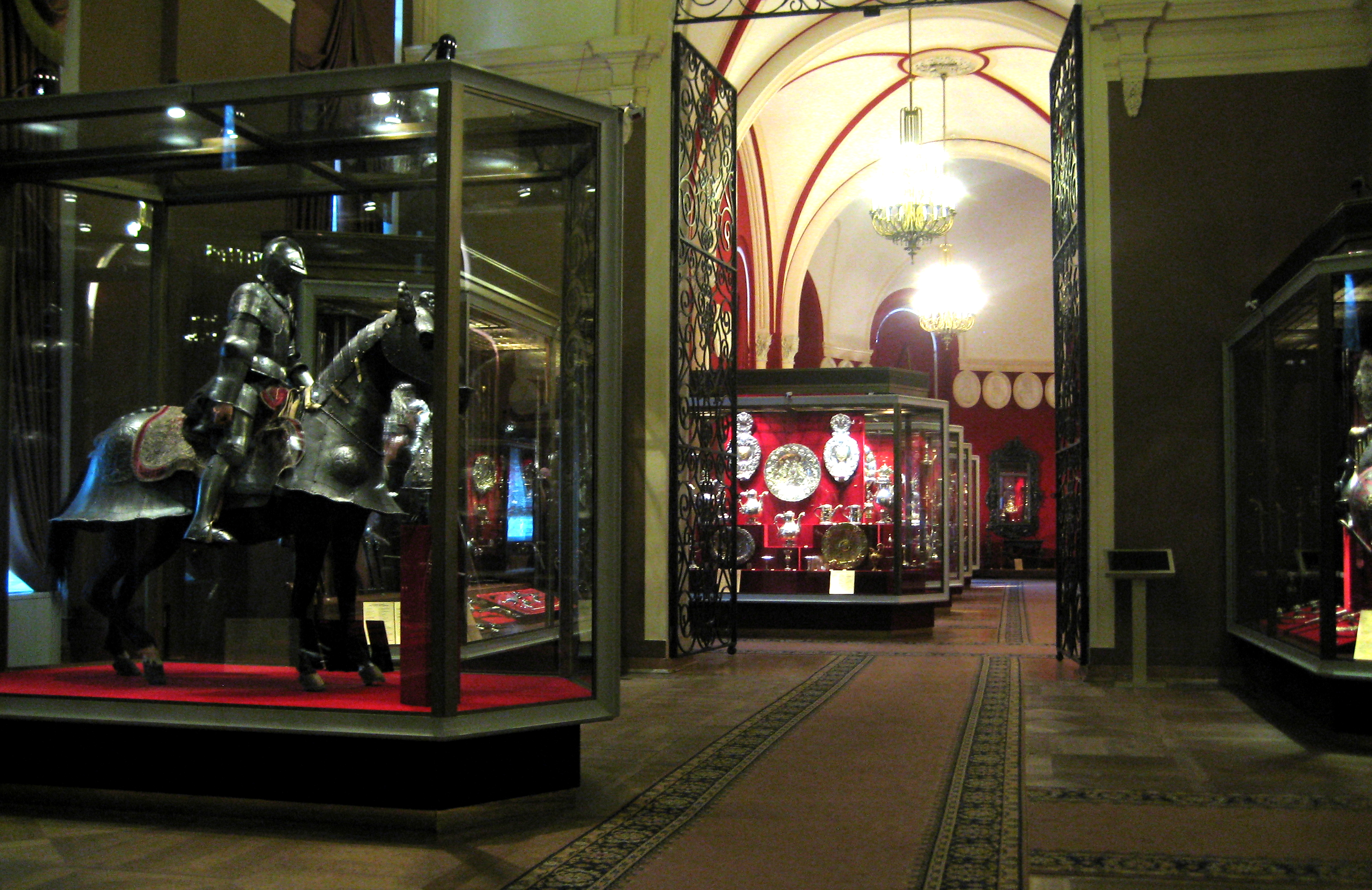|
Vozok
Vozok (возок) is a type of closed winter sled that was used throughout Russia until the late 19th century. With the aim of reducing heat loss, the vozok usually had very small windows and sometimes a furnace to keep it warm. Inside it was quite dark. Vozoks provided a high-speed means of transport through the snow-covered plains of European Russia and Siberia. It was a means of transport preferred by royals, bishops, and boyars of Muscovy. One patriarch is known to have used covered sleds even in summertime. A miniature vozok of Tsarevich Peter Peter may refer to: People * List of people named Peter, a list of people and fictional characters with the given name * Peter (given name) ** Saint Peter (died 60s), apostle of Jesus, leader of the early Christian Church * Peter (surname), a su ... and several other royal sleds of historical importance have been preserved in the Kremlin Armoury. References {{Horse-drawn carriages Animal-powered vehicles Carriages Russi ... [...More Info...] [...Related Items...] OR: [Wikipedia] [Google] [Baidu] |
Sled
A sled, skid, sledge, or sleigh is a land vehicle that slides across a surface, usually of ice or snow. It is built with either a smooth underside or a separate body supported by two or more smooth, relatively narrow, longitudinal runners similar in principle to skis. This reduces the amount of friction, which helps to carry heavy loads. Some designs are used to transport passengers or cargo across relatively level ground. Others are designed to go downhill for recreation, particularly by children, or competition (compare cross-country skiing with its downhill cousin). Shades of meaning differentiating the three terms often reflect regional variations depending on historical uses and prevailing climate. In British English, ''sledge'' is the general term, and more common than ''sled''. '' Toboggan'' is sometimes used synonymously with ''sledge'' but more often to refer to a particular type of sledge without runners. ''Sleigh'' refers to a moderate to large-sized, usuall ... [...More Info...] [...Related Items...] OR: [Wikipedia] [Google] [Baidu] |
Russia
Russia, or the Russian Federation, is a country spanning Eastern Europe and North Asia. It is the list of countries and dependencies by area, largest country in the world, and extends across Time in Russia, eleven time zones, sharing Borders of Russia, land borders with fourteen countries. Russia is the List of European countries by population, most populous country in Europe and the List of countries and dependencies by population, ninth-most populous country in the world. It is a Urbanization by sovereign state, highly urbanised country, with sixteen of its urban areas having more than 1 million inhabitants. Moscow, the List of metropolitan areas in Europe, most populous metropolitan area in Europe, is the capital and List of cities and towns in Russia by population, largest city of Russia, while Saint Petersburg is its second-largest city and Society and culture in Saint Petersburg, cultural centre. Human settlement on the territory of modern Russia dates back to the ... [...More Info...] [...Related Items...] OR: [Wikipedia] [Google] [Baidu] |
Siberia
Siberia ( ; , ) is an extensive geographical region comprising all of North Asia, from the Ural Mountains in the west to the Pacific Ocean in the east. It has formed a part of the sovereign territory of Russia and its predecessor states since the lengthy conquest of Siberia, which began with the fall of the Khanate of Sibir in 1582 and concluded with the annexation of Chukotka in 1778. Siberia is vast and sparsely populated, covering an area of over , but home to roughly a quarter of Russia's population. Novosibirsk, Krasnoyarsk, and Omsk are the largest cities in the area. Because Siberia is a geographic and historic concept and not a political entity, there is no single precise definition of its territorial borders. Traditionally, Siberia spans the entire expanse of land from the Ural Mountains to the Pacific Ocean, with the Ural River usually forming the southernmost portion of its western boundary, and includes most of the drainage basin of the Arctic Ocean. I ... [...More Info...] [...Related Items...] OR: [Wikipedia] [Google] [Baidu] |
Boyar
A boyar or bolyar was a member of the highest rank of the feudal nobility in many Eastern European states, including Bulgaria, Kievan Rus' (and later Russia), Moldavia and Wallachia (and later Romania), Lithuania and among Baltic Germans. Comparable to Dukes/Grand Dukes, Boyars were second only to the ruling princes, grand princes or tsars from the 10th to the 17th centuries. Etymology Also known as ''bolyar''; variants in other languages include or ; , , ; , ; and . The title Boila is predecessor or old form of the title Bolyar (the Bulgarian word for Boyar). Boila was a title worn by some of the Bulgar aristocrats (mostly of regional governors and noble warriors) in the First Bulgarian Empire (681–1018). The plural form of boila ("noble"), ''bolyare'' is attested in Bulgar inscriptions and rendered as ''boilades'' or ''boliades'' in the Greek of Byzantine documents. Multiple different derivation theories of the word have been suggested by scholars and linguists ... [...More Info...] [...Related Items...] OR: [Wikipedia] [Google] [Baidu] |
Tsardom Of Russia
The Tsardom of Russia, also known as the Tsardom of Moscow, was the centralized Russian state from the assumption of the title of tsar by Ivan the Terrible, Ivan IV in 1547 until the foundation of the Russian Empire by Peter the Great in 1721. From 1550 to 1700, Russia grew by an average of per year. The period includes the Time of Troubles, upheavals of the transition from the Rurik Dynasty, Rurik to the House of Romanov, Romanov dynasties, wars with the Polish–Lithuanian Commonwealth, Swedish Empire, Sweden, and the Ottoman Empire, and the Russian conquest of Siberia, to the reign of Peter the Great, who took power in 1689 and transformed the tsardom into an empire. During the Great Northern War, he implemented government reform of Peter I, substantial reforms and proclaimed the Russian Empire after Treaty of Nystad, victory over Sweden in 1721. Name While the oldest Endonym and exonym, endonyms of the Grand Principality of Moscow used in its documents were "Rus'" () and ... [...More Info...] [...Related Items...] OR: [Wikipedia] [Google] [Baidu] |
Peter The Great
Peter I (, ; – ), better known as Peter the Great, was the Sovereign, Tsar and Grand Prince of all Russia, Tsar of all Russia from 1682 and the first Emperor of Russia, Emperor of all Russia from 1721 until his death in 1725. He reigned jointly with his half-brother Ivan V of Russia, Ivan V until 1696. From this year, Peter was an Absolute monarchy, absolute monarch, an autocrat who remained the ultimate authority and organized a well-ordered police state. Much of Peter's reign was consumed by lengthy wars against the Ottoman Empire, Ottoman and Swedish Empire, Swedish empires. His Azov campaigns were followed by the foundation of the Imperial Russian Navy, Russian Navy; after his victory in the Great Northern War, Russia annexed a Treaty of Nystad, significant portion of the eastern Baltic Sea, Baltic coastline and was officially renamed from a Tsardom of Russia, tsardom to an Russian Empire, empire. Peter led a cultural revolution that replaced some of the traditionalist ... [...More Info...] [...Related Items...] OR: [Wikipedia] [Google] [Baidu] |
Kremlin Armoury
The Kremlin ArmouryOfficially called the "Armoury Chamber" but also known as the cannon yard, the "Armoury Palace", the "Moscow Armoury", the "Armoury Museum", and the "Moscow Armoury Museum" but different from the Kremlin Arsenal. () is one of the oldest museums in Moscow. It is located in the Moscow Kremlin, and is a part of the Moscow Kremlin Museums, Moscow Kremlin Museum. The Kremlin Armory (military), Armoury originated as the royal arsenal in 1508. Until the transfer of the court to St Petersburg, the Armoury was in charge of producing, purchasing and storing weapons, jewelry and various household articles of the tsars. The finest Muscovite gunsmiths (the Vyatkin brothers), jewelers (Gavrila Ovdokimov), and painters (Simon Ushakov) used to work there. In 1640 and 1683, they opened the iconography and pictorial studios, where the lessons on painting and handicrafts could be given. In 1700, the Armoury was enriched with the treasures of the Golden and Silver chambers of the ... [...More Info...] [...Related Items...] OR: [Wikipedia] [Google] [Baidu] |
Carriages
A carriage is a two- or four-wheeled horse-drawn vehicle for passengers. In Europe they were a common mode of transport for the wealthy during the Roman Empire, and then again from around 1600 until they were replaced by the motor car around 1900. They were generally owned by the rich, but second-hand private carriages became common public transport, the equivalent of modern cars used as taxis. Carriage suspensions are by leather strapping or, on those made in recent centuries, steel springs. There are numerous names for different types. Two-wheeled carriages are usually owner-driven. Coaches are a special category within carriages. They are carriages with four corner posts and a fixed roof. Two-wheeled war chariots and transport vehicles such as four-wheeled wagons and two-wheeled carts were forerunners of carriages. In the 21st century, horse-drawn carriages are occasionally used for public parades by royalty and for traditional formal ceremonies. Simplified modern versio ... [...More Info...] [...Related Items...] OR: [Wikipedia] [Google] [Baidu] |
Russian Inventions
This timeline of Russian innovation encompasses key events in the history of technology in Russia. The entries in this timeline fall into the following categories: * indigenous invention, like airliners, AC transformers, radio receivers, television, artificial satellites, ICBMs * uniquely Russian products, objects and events, like Saint Basil's Cathedral, Matryoshka dolls, Russian vodka * products and objects with superlative characteristics, like the Tsar Bomba, the AK-47, and the Typhoon-class submarine * scientific and medical discoveries, like the periodic law, vitamins and stem cells This timeline includes scientific and medical discoveries, products and technologies introduced by various peoples of Russia and its predecessor states, regardless of ethnicity, and also lists inventions by naturalized immigrant citizens. Certain innovations achieved internationally may also appear in this timeline in cases where the Russian side played a major role in such projects. ... [...More Info...] [...Related Items...] OR: [Wikipedia] [Google] [Baidu] |
Sledding
Sledding, sledging or sleighing is a winter sport typically carried out in a prone or seated position on a vehicle generically known as a sled (North American), a sledge (British), or a sleigh. It is the basis of three Olympic sports: luge, Skeleton (sport), skeleton and bobsledding. When practised on sand, it is known as a form of sandboarding. In Russia sledges are used for maritime activities including fishing and commuting from island to island on ice. History The practical use of sleds is ancient and widespread. They were never developed in areas with inconsistent winter snow cover, as vehicles to transport materials and/or people failed, far more people walked than used wheeled vehicles in icy and snowy conditions. Early designs included hand-pulled sizes as well as larger dog, horse, or ox drawn versions. Early examples of sleds and sledges were found in the Oseberg ship, Oseberg Viking ship excavation. The Toboggan sled is also a traditional form of transport used by ... [...More Info...] [...Related Items...] OR: [Wikipedia] [Google] [Baidu] |





